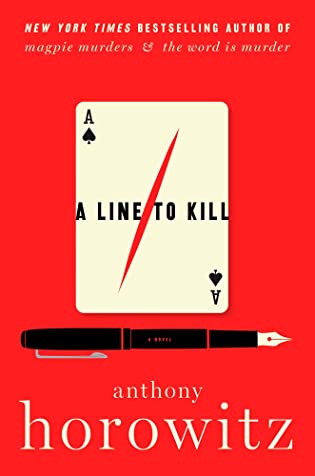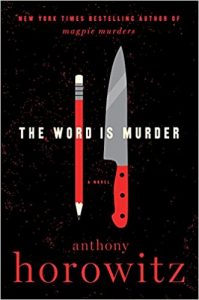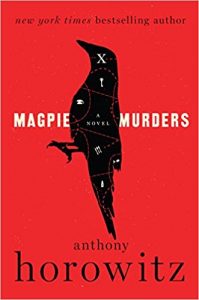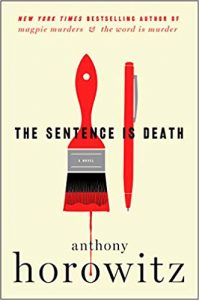 A Line To Kill (Hawthorne and Horowitz Mystery, #3) by Anthony Horowitz
A Line To Kill (Hawthorne and Horowitz Mystery, #3) by Anthony Horowitz Format: eARC
Source: supplied by publisher via Edelweiss
Formats available: hardcover, paperback, ebook, audiobook
Genres: mystery, thriller
Series: Hawthorne and Horowitz #3
Pages: 384
Published by Harper on October 19, 2021
Purchasing Info: Author's Website, Publisher's Website, Amazon, Barnes & Noble, Kobo, Bookshop.org
Goodreads
The New York Times bestselling author of the brilliantly inventive The Word Is Murder and The Sentence Is Death returns with his third literary whodunit featuring intrepid detectives Hawthorne and Horowitz.
When Ex-Detective Inspector Daniel Hawthorne and his sidekick, author Anthony Horowitz, are invited to an exclusive literary festival on Alderney, an idyllic island off the south coast of England, they don’t expect to find themselves in the middle of murder investigation—or to be trapped with a cold-blooded killer in a remote place with a murky, haunted past.
Arriving on Alderney, Hawthorne and Horowitz soon meet the festival’s other guests—an eccentric gathering that includes a bestselling children’s author, a French poet, a TV chef turned cookbook author, a blind psychic, and a war historian—along with a group of ornery locals embroiled in an escalating feud over a disruptive power line.
When a local grandee is found dead under mysterious circumstances, Hawthorne and Horowitz become embroiled in the case. The island is locked down, no one is allowed on or off, and it soon becomes horribly clear that a murderer lurks in their midst. But who?
Both a brilliant satire on the world of books and writers and an immensely enjoyable locked-room mystery, A Line to Kill is a triumph—a riddle of a story full of brilliant misdirection, beautifully set-out clues, and diabolically clever denouements.
My Review:
Think of this story, in fact, think of this entire series, as taking place surrounded by the rubble of the “fourth wall” that author Anthony Horowitz continually demolishes by making himself a character in his own series.
And not even the hero of it. He’s the narrator, but he’s definitely not the star of this show. That position is reserved for – really taken over by – detective Daniel Hawthorne, formerly of the London Metropolitan Police and currently working for himself and whoever is willing to pay him to figure out whodunnit when the Met is stumped.
Or when he’s way, way off their patch, as he and “Tony” are in this story.
 After the previous books in this series, The Word is Murder and The Sentence is Death, where Hawthorne barges in, completely disrupts “Tony’s” life, drags him along on a case and never lets the man catch his breath, this case begins when Tony reluctantly agrees with his agent’s notion to send both himself and Hawthorne to a literary festival in the Channel Islands. Tony hopes that this will finally be the first time in their contentious acquaintance that Tony will be in his element and Hawthorne will need at least a little bit of his help and guidance.
After the previous books in this series, The Word is Murder and The Sentence is Death, where Hawthorne barges in, completely disrupts “Tony’s” life, drags him along on a case and never lets the man catch his breath, this case begins when Tony reluctantly agrees with his agent’s notion to send both himself and Hawthorne to a literary festival in the Channel Islands. Tony hopes that this will finally be the first time in their contentious acquaintance that Tony will be in his element and Hawthorne will need at least a little bit of his help and guidance.
But Hawthorne has an agenda of his own on Alderney and is just going along with this literary festival idea for the ride to a place he wants to get to anyway. And, as much as this might not be the mostly anti-social Hawthorne’s natural setting – he’s VERY good at playing whatever part is necessary to get him who and what he needs to achieve whatever he’s set out to do.
Whatever Hawthorne’s private agenda, and Tony’s anger and disappointment when he figures it out, their entire reason for being on Alderney ends up taking a back seat to murder. Specifically the murder of the man responsible for funding the literary festival, and coincidentally – or perhaps not – responsible for the current controversy that is tearing tiny Alderney apart.
Considering that Alderney has a population of around 2,000, it’s not much of a surprise that they have a police force of 3. That none of the three are actually available to work this case is a bit of an issue, but considering that no one can remember the last time there was a murder on Alderney, they’re not much missed. But the police force on the nearby islands isn’t much bigger – or much more experienced with murder. (If anyone remembers the TV series Bergerac, there’s no one like him anywhere in evidence – and this was a case that could certainly have used an experienced detective with local knowledge and no axe to grind.)
Naturally they ask for Hawthorne’s help. And just as naturally, Hawthorne assumes that Tony will tag along as chronicler, occasional foil, and, just as important from Hawthorne’s perspective, the person who will pay all the bills.
So Tony finds himself in the exact position he had no desire to be in again, serving as Watson to Hawthorne’s Sherlock – and one of the less ept Watsons into the bargain. Meanwhile Hawthorne is on the track of a murderer that Tony is certain no one will feel an ounce of sympathy for, making any book coming out of this case a nonstarter.
However, as their previous cases have proven, in the end Hawthorne is always right, and Tony is inevitably barking up the wrong tree when it comes to figuring out whodunnit. There might be a book in this mess after all.
 Escape Rating B+: Both of the author’s current series, the Susan Ryeland series that starts with Magpie Murders and the Hawthorne and Horowitz series, take the concepts of a classic murder mystery and wrap them up in ways that the authors of those classics never would have thought of.
Escape Rating B+: Both of the author’s current series, the Susan Ryeland series that starts with Magpie Murders and the Hawthorne and Horowitz series, take the concepts of a classic murder mystery and wrap them up in ways that the authors of those classics never would have thought of.
In the Susan Ryeland series, that’s literal, as the classic-style mysteries of Atticus Pünd, which are included in their entirety in each book, provide clues to the more recent murder that Susan Ryeland is bumbling her way towards solving.
In the Hawthorne and Horowitz series it’s a bit more of a stretch, but still definitely there, and not just because the main characters are so obviously avatars for Holmes and Watson, albeit a Holmes who is even more sociopathic and self-absorbed than the original, leading around a Watson who is even more bumbling. Not that saying any of that doesn’t feel slightly weird, as it’s the author of the book inserting himself into the narrative as a character, which gets more than a bit meta.
But the mystery that Hawthorne is presented with in this case begins as something that Dame Agatha Christie – at least in the person of Hercule Poirot – would have had a great time solving. The victim is wealthy – and he’s an absolute bastard. The line of people wanting to murder him is long, to the point where the title of the book is a pun on the concept. Alderney is a relatively remote location, an island that can be closed so that the potential suspects are forced to remain, while the murder itself begins as a locked room murder in the victim’s own mansion.
All of those are plot elements that Christie played with more than once, and quite successfully. It’s not a surprise that another mystery writer would take those same ingredients and make something quite a bit different from them. Because, of course, nothing is quite as it seems.
Except the victim’s bastardy. That was most definitely real. And the point of quite a lot.
The case is even more complicated than it initially appeared to be. At first, it just seems difficult, but as Hawthorne digs into the lives and motives of the potential suspects, it gets deeper as well. And puts at least some of his own motives for coming to Alderney on display. A bit. As much as Hawthorne ever displays much of any part of his internal life.
Or to put it another way, once the body was discovered, the story got really fascinating really quickly. It was much more fun following Horowitz following Hawthorne as he investigated than it was hanging around as Tony groused – mostly to himself – about getting there and being there and dealing with Hawthorne and the other authors at the festival.
The other stories in this series started with murder. This one takes a while to work itself up to that sticking point. Once it does, it’s off to the races, while throwing out plenty of red herrings for the reader, along with Tony, to chew on.
 The thing is, Tony doesn’t actually like Hawthorne, which is fair, because Hawthorne is not at all likeable. It makes the early part of this book awkward because all of their interactions are frustrating, and Tony is clearly frustrated by pretty much everything involved in his odd relationship with Hawthorne. Absent a case, their conversations seem rather forced – only because they are. But it makes for a bit of a slow read until they have a case in hand.
The thing is, Tony doesn’t actually like Hawthorne, which is fair, because Hawthorne is not at all likeable. It makes the early part of this book awkward because all of their interactions are frustrating, and Tony is clearly frustrated by pretty much everything involved in his odd relationship with Hawthorne. Absent a case, their conversations seem rather forced – only because they are. But it makes for a bit of a slow read until they have a case in hand.
Also, and very much the point, Tony may not like Hawthorne, but he is utterly fascinated by him. And so are we. So once Hawthorne is in his element, solving a mystery, the relationship between them falls into a place from which we can watch the master at his work – even if, or especially because, we can’t see where he’s heading with it until the end. Or somebody’s end. Or both.
“Tony” may not want to work with Hawthorne again. Ever. But I really hope he does.






















One thought on “Review: A Line to Kill by Anthony Horowitz”
Comments are closed.